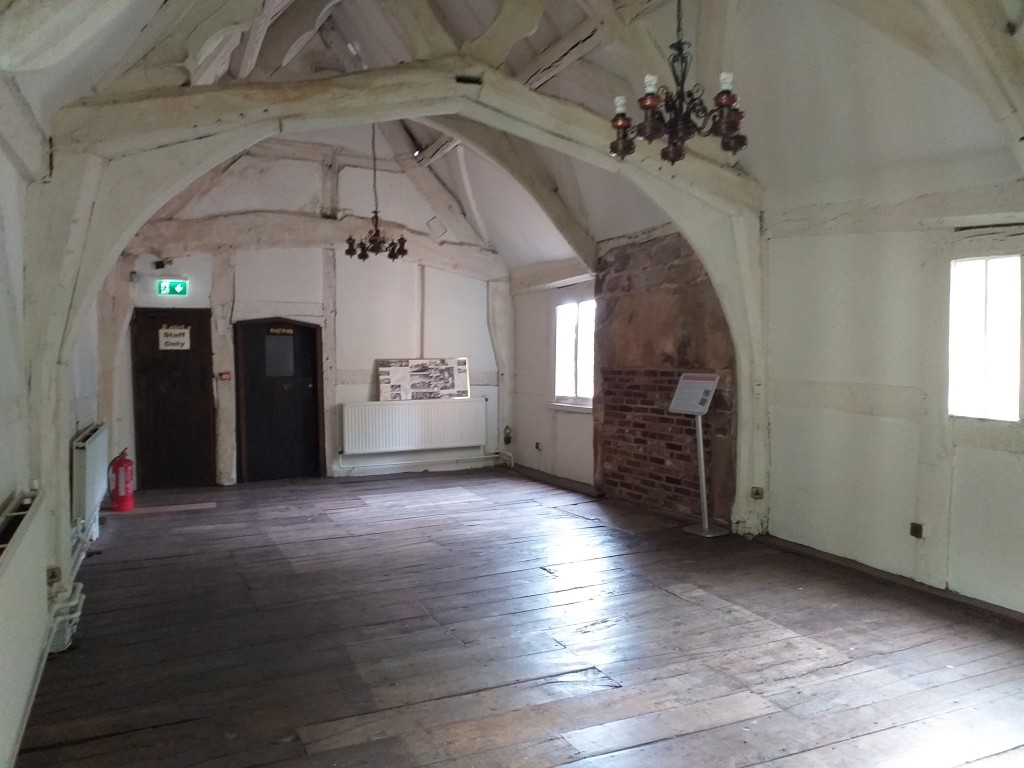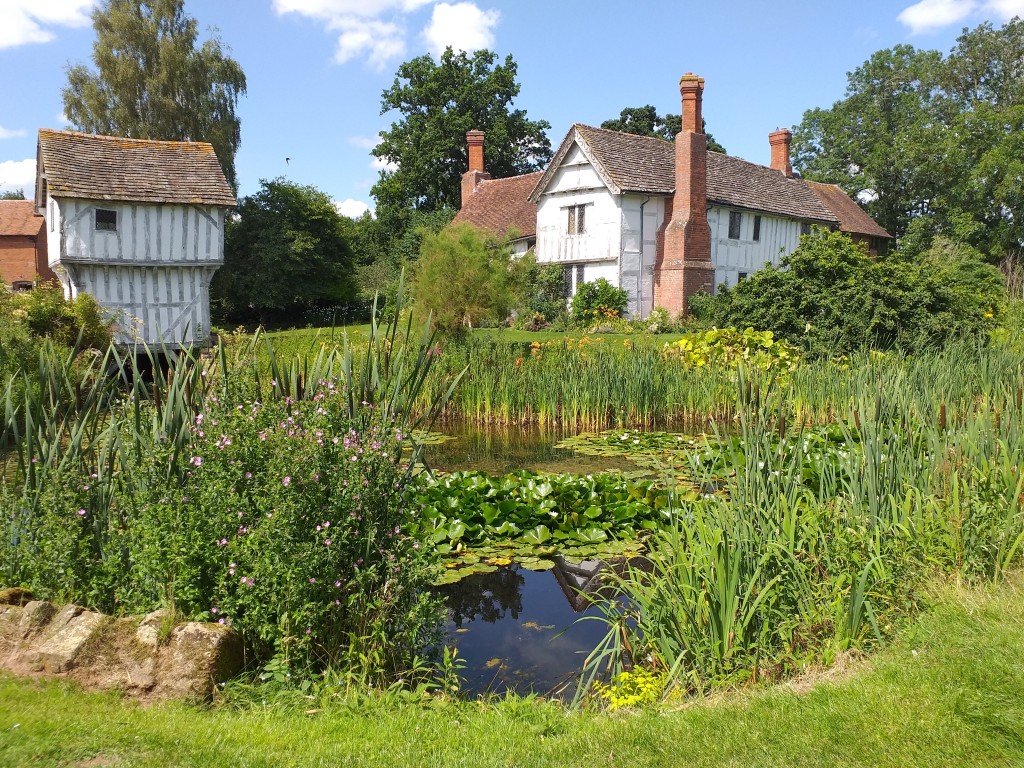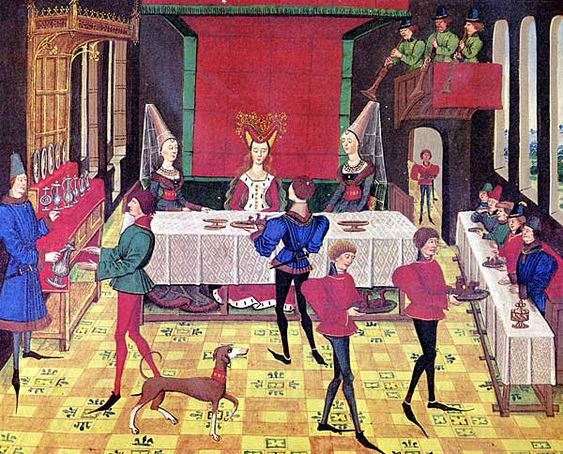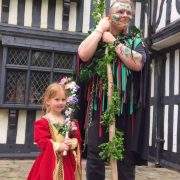
Staff at Bromwich Hall- The Manor House Museum have been asked this question on several occasions. Well actually it isn’t pink, it is red ochre and we’ve painted over other parts of the building with yellow ochre, gold ochre and what looks like a lime wash!
What! painting a medieval building bright colours, why? Shouldn’t they be black and white? I hear some of you cry!

I was also once asked the question
‘Why have you decorated the great hall at the Manor House like this – it would have been much more rustic, it was medieval times after all’

We’ve all seen movies and TV programmes about medieval times where peasants have mud and dung on their faces and matted hair, where the rich and powerful live in large foreboding black and white timber framed Manor Houses or in cold draft ridden castles with bare stone walls and dark wooden furniture. In Robin Hood Prince of Thieves, Marian appears to be living in a ruin at times (and we won’t even mention how Robin intends to get from the south coast to Nottingham on foot via Hadrian’s Wall by sundown as it isn’t relevant to this discussion).

So have we taken leave of our senses by painting the Manor House with red, gold and yellow, putting up stripy hangings and decorating it with beautifully carved light in colour oak furniture? No not at all, in fact we haven’t gone far enough…yet!
There is plenty of evidence to suggest that medieval buildings belonging to the wealthy were full of bright cloth and handsome furnishings, that walls were plastered and painted and hung with decorated or woven cloth (or tapestries if you were one of the very richest people around).

The medieval period ended over 500 years ago so what we have left today is often a very faded version of what once would have been there, but there are many clues to show that castles didn’t have bare stone walls and manor houses weren’t black and white and even the homes of the more moderately wealthy like merchants had some colour. The medieval world has left behind traces of wall paintings and hangings, floor tiles, medieval illustrations showing painted rooms and furniture, remnants of cloth and some descriptions. As well as items that people would have put inside their homes such as pottery and metalwork.
Restoration work at The Manor House revealed traces of a red chevron pattern on some of the wooden beams. It is likely that most, if not all of the beams would have been painted over with designs and patterns or at very least painted in the same colour as the rest of the room and then hung with textile hangings. The black and white look was invented by the Victorians as they thought it looked pretty and fitting.
There now follows a few of my holiday snaps to illustrate this point…. (I can hear you all thinking ‘what a nerd’)

Here is the faded but rather lovely remains of a painted beam at St Nicholas Place in Kings Norton, Birmingham which I got rather excited about and took a picture of when I visited recently. You can clearly see the remains of a red/brown design. The house is a rather nice high status, late 1400s merchant’s residence and like all rich houses would have been full of colour.

The picture above was taken at Cleeve Abbey in Somerset. It shows the remains of painted plaster which would have been very striking in the 15th century when it was painted.

The wall painting above is from the abbot’s office, also at Cleeve Abbey. Although these are in a religious rather than a domestic setting it does show that painted plaster was common in the medieval period.
Tretower Court on the Welsh borders (now run by Cadw) has also gone a long way to decorating their great hall as it might have looked in the 1400s (like our decorations at West Bromwich). However in medieval times the walls and the wooden screen you can see hiding the screens passage would most likely have been painted too in bright colours and designs. I must admit I am rather jealous of their screen as we don’t have ours. Also note some of the replica pieces of furniture which are beautifully carved and sometimes painted.


Gainsborough Old Hall in Lincolnshire has also had many of its rooms displayed in a 15th century style. Again Gainsborough was a Hall or manor house building so a similar level of wealth and social status to the families living at West Bromwich Manor House.


The outside of buildings would also have been painted and the beams would have been painted over the same colour as the infills. Buildings may have been painted in red ochre or even ox blood (which gave a pink colour), yellow or gold or off white colour, it usually depended on what were local colour pigments or traditions.

By exploring pictures produced in the medieval period you can clearly see that nobody is sitting about in bare stone rooms without colour or cushions. That colour and textiles and decorations were in abundance if you could afford it.
The medieval period was full of very well trained and talented people who made furniture, carved wood, spun and wove cloth, painted designs on walls and hangings, illuminated manuscripts, made jewellery and clothes and carved stone. Imported goods were also popular such as fine silks, glassware and much more. There was no need for people to live with bare stone or black and white walls and with gloomy dark wooden furniture roughly whittled out of logs and why would they want to? People wanted luxury and comfort and to showcase their wealth and status.


On that note, what about the peasants with dung on their faces and matted hair – again a Hollywood myth. Medieval peasants are never drawn looking filthy or with their heads uncovered in any illustrations from the period. Their clothes are simple and ordinary as was their lives but for many ordinary medieval people they would have cared about the things they did own and how they presented themselves. (Look at some of the images of farm workers shown in the Luttrell Psalter, kept int he British Library https://www.bl.uk/collection-items/the-luttrell-psalter ). But the ordinary folk is a story for another day.
If you want to see Bromwic Hall – The Manor House Museum come to life as it might have been in the 1400s with Lords and Ladies, soldiers, knights and servants then visit us this weekend on 12th and 13th October 2019 11am-4pm and discover life in a medieval manor house as Buckingham’s retinue re-enactment group bring the house to life. £1 entry, free parking on site. Activities for young visitors too. Visit our listings page at http://www.sandwell.gov.uk/joininmuseums for times of activities.



Ashwell Village Museum has had the same questions asked about its ‘new’ exterior after renovation. It is now limewashed all over. When it was opened as a museum in 1930 it had the plaster stripped and became black and white but like most other timber buildings here for most of its life it would have been rendered all over – but we felt that was too much of a shock for todays audience.
LikeLiked by 1 person
yes i think it is quite a shock for people and some would rather have museums looking ‘pretty’ as they see it rather than telling their story. You have to make decisions and get the balance right.
LikeLike